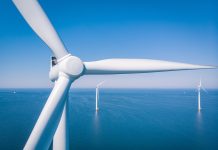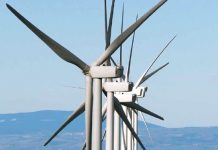Havlik Gear in Cambridge, Ontario is one of several companies competing in the wind energy component market. During the early part of the new millennium, wind power has expanded all over North America, and in particular from a Canadian perspective, in Southern Ontario. In the past, the large gearing market had been dominated by mining and other industries that require large, heavy pitch gearing. With a recent expansion and acquisition of key pieces of equipment, the company is well-positioned in the wind energy market as a prime supplier of gearing and related products.
Gears used in wind power generation usually fall into two categories, namely speed-increaser gears for the actual power generation, and low-speed slewing gears for pitch and yaw mechanisms. From a design and manufacturing standpoint, there are some key differences and necessary considerations that apply to drivetrains used in wind power versus traditional applications. Most machinery operates either on or off, and the failure mode of the associated gearing is either surface failure or bending failure (crack propagation or severe overload). Drivetrains used in wind power generation see other stresses in addition to the ones listed above, one common example is from surface stress and/or particle transfer caused by small vibrations or motions introduced to the teeth while a turbine is stopped. During this condition, lubrication systems are not necessarily functioning and the lubricant’s film strength is quickly broken down. These new scenarios are not yet quantified by existing design standards and are therefore left up to the designer and manufacturer to solve together depending on the individual case. Havlik has worked with several customers to achieve a high-quality product that meets all of the designer’s requirements while staying within the customers’ budget.
In Cambridge, Ontario, Havlik Gear operates two gear manufacturing facilities, each with unique capabilities. The newest location includes a large form gear grinder, namely a Niles ZP40. The Niles machine can grind external gears up to four meters, and internal gears up to approximately 3.5 meters depending on the proportions of the cross section. Internal gear grinding is critical to the manufacturing of gears for the wind industry. The most highly scrutinized drivetrain component usually becomes the main internal ring gear or “annulus gear” used in the speed increaser gearbox. The annulus gear typically has high power capacity with slender cross sectional proportions due to size and weight restrictions. The result is a gear design that has absolutely no room for imperfections, is made from the highest strength material, and is subjected to best heat treatments available. There is a laundry list of processes and inspections that need to occur before a gear blank can finally be ground to an impressive mirror finish and very high AGMA or DIN quality. On average for a typical case hardened ring gear produced by Havlik, there are several inspections that occur during the process. From the raw material stage there is tensile, chemical, ultrasonic, and hardness testing. After heat treatment there is complete microstructure analysis of the case and core along with destructive testing of coupons to determine exact effective depth of case. After final gear grinding it has become necessary to chemically etch sample numbers of gear teeth with the goal of identifying areas that have been overheated by the grinding operation. The etching is done as a precaution however with advancements in gear grinding technology both in operating principal and in availability of composite grinding wheels of more favorable composition the risk of overheating has greatly reduced from what it once was. The inspections listed are in addition to the standard dimensional and gear tooth geometry checks which are standard practice.
On the economic side of the equation, Havlik uses five-axis milling machines to rough cut gear teeth within one millimeter of finished size. Gear tooth profiles are accurately milled and therefore the finishing stock is very consistent which helps to avoid heavy and light areas of grinding which can cause many issues such as cracking or variations in surface hardness and/or depth. Five-axis milling has proven to be the greatest factor in the company’s ability to compete and remain flexible in the wind power market. Havlik Gear can produce both prototypes and production parts for its customers in a cost effective way while meeting specific quality requirements. When requested, Havlik Gear is able to provide consulting services and guidance to its customers with respect to gear design or manufacturing. In several cases Havlik Gear has been presented with a concept or basic design and together with its customer developed that concept to a final product that is adequate for service, cost effective, and practical to manufacture.



























